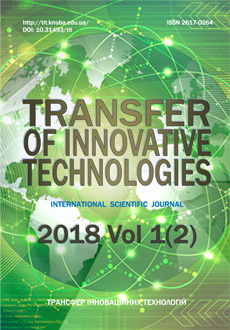The methods of homotopic skeletonization of bit-mapped drawings of parts of sea transport
DOI:
https://doi.org/10.31493/tit1812.0401Keywords:
drawing, shape, skeleton, extractor, distortion coherence, homotopic characterAbstract
Solution of the problem of recognition and vectorization of parts of sea transport requires formation of skeletonized images, homotopic (geometrical primitives, topologically equivalent in shape and their coherence) to parts’ shapes. The author has performed a comparative analysis of the best methods of parallel, topological skeletonization of the area objects, based upon application of space extractors. The analysis showed that the methods existing in the investigated objects zone possessed typical drawbacks, expressed in iterative distortions of primitive topology and their compositions. The objective of the article is to through the light upon the developed methods of improvement of topological equivalence of the resulting skeletons to the shapes of the parts of sea transport, by means of gradual correction of typical distortions of skeletons. The developed methods assumes correction of skeleton’s iterative distortions by modified extractors of the principal method of skeletonization and restoration of the resulting skeleton by extractors of restoration of homotopic skeleton, on the basis of developed rules of its reconstruction. Execution of the proposed method was carried out on example of the basic method Wu R.Y. & Tsai W.H. Examples of the results of skeletonization of parts’ drawings were given, verifying efficiency of the proposed methods. The methods can be adapted to the methods of topological skeletonization of area objects, based upon application of space extractors.References
Liu W., & Dori D., 2014. Algorithms for 2D Engineering Drawings Recognition The analysis of testing of the developed methods of twostaged improvement of Saarbrücken: LAP LAMBERT Academic Publishing.
Chiang J. Y., Tue S., & Leu Y., 1998. A New Algorithm For Line Image Vectorization. Pattern Recognition, 31(10), 1541-1549. doi:10.1016/s0031-3203(97)00157-x.
Zhang, T. Y., & Suen, C. Y., 1984. A fast parallel algorithm for thinning digital patterns. Communications of the ACM, 27(3), 236-239. doi:10.1145/357994.358023.
Kushnir O., 2012. Sravnenie formy binarnyh rastrovyh izobrazhenij na osnove skeletizacii. Mashinnoe obuchenie i analiz dannyh, 3, 252263 (in Russian).
Roseborough J.B. & Murase H., 1995. Partial eigenvalue decomposition for large image sets using run-length encoding. Pattern Recognition, 28(3), 421-430. doi:10.1016/00313203(94)00113-z.
Baranov R. & Favorskaja M., 2011. Algoritmy skeletizacii ob#ektov na izobrazhenii. Aktual'nye Problemy Aviacii I Kosmonavtiki, 7(1), 349-356 (in Russian).
Klubkov I., 2001. Primenenie volnovogo algoritma dlja nahozhdenija skeleta rastrovogo izobrazhenija. Vestnik DGTU, 1(7), 9-16 (in Russian).
Ablamejko S. & Lagunovskij D., 2000. Obrabotka izobrazhenij: tehnologija, metody, primenenie (1st ed., 304). Minsk, Amalfeja (in Russian).
Hori, O. & Tanigawa, S., 1993. Raster-tovector conversion by line fitting based on contours and skeletons. Proceedings of 2nd International Conference on Document Analysis and Recognition (ICDAR 93), 272-281. doi:10.1109/icdar.1993.395716.
Gonsales R., Vuds R. & Jeddins S., 2006. Cifrovaja obrabotka izobrazhenij v srede Matlab (3rd ed., 616). Moskva: Tehnosfera (in Russian).
Tropchenko A., 2012. Metody vtorichnoj obrabotki izobrazhenij i raspoznavanija ob#ektov: uchebnoe posobie (1st ed., p. 52). Sankt-Peterburg: ITMO (in Russian).
Arcelli C., Cordella L. & Levialdi, S., 1975. Parallel thinning of binary pictures. Electronics Letters, 11(7), 148-149. doi:10.1049/el: 19750113.
Bernard T., & Manzanera A., 1999. Improved low complexity fully parallel thinning algorithm. Proceedings 10th International Conference on Image Analysis and Processing, 215-220. doi:10.1109/iciap.1999.797597. 14. Chin R.T., Wan, H., Stover, D. & Iverson R., 1987. A one-pass thinning algorithm and its parallel implementation. Computer Vision, Graphics, and Image Processing, 40(1), 30-40. doi:10.1016/s0734-189x(87)80139-1.
Eckhardt U., & Latecki L., 1996. Invariant Thinning and Distance Transform. Computing Supplement Theoretical Foundations of Computer Vision, 21-36. doi:10.1007/978-3-70916586-7_2.
Guo Z., & Hall R. W., 1992. Fast fully parallel thinning algorithms. CVGIP: Image Understanding, 55(3), 317-328. doi:10.1016/10499660(92)90029-3.
Jagna A., 2014. An Efficient Image Independent Thinning Algorithm. Ijarcce, 8309-8311. doi:10.17148/ijarcce.2014.31052.
Wu R., & Tsai W., 1992. A new one-pass parallel thinning algorithm for binary images. Pattern Recognition Letters, 13(10), 715-723. doi:10.1016/0167-8655(92)90101-5.
Guo T., Zhang H. & Wen Y., 2012. An improved example-driven symbol recognition approach in engineering drawings. Computers & Graphics, 36(7), 835-845. doi:10.1016/j.cag. 2012.06.001.
Ye X., & Deng Y., 2009. Line interpolation algorithm based on diagonal run-length. Journal of Computer Applications, 28(9), 22702273. doi:10.3724/sp.j.1087.2008.02270.
Dong J., Lin W. & Huang, C., 2016. An improved parallel thinning algorithm. 2016 International Conference on Wavelet Analysis and Pattern Recognition (ICWAPR). doi:10.1109/ cwapr.2016.7731637.
Jang B.K., & Chin R.T., 1994. Reconstructable Parallel Thinning. Series in Machine Perception and Artificial Intelligence Thinning Methodologies for Pattern Recognition, 181217. doi:10.1142/9789812797858_0010.
Sirivchuk A., 2017. The development of mathematical model for the control of the trajectory of the motion of an underwater vehicle. Underwater Techologies, 05/2017, 32-39.
Priymachenko O. & Kobzar O., 2018. Methodology of studies for selecting engineering decisions in territory planning. Transfer of Innovative Technologies, Vol.1(1), 17-25. doi:10.31493/tit1811.0102.
Downloads
How to Cite
Issue
Section
License
Copyright (c) 2020 Transfer of Innovative Technologies

This work is licensed under a Creative Commons Attribution-NonCommercial-NoDerivatives 4.0 International License.
Our journal abides by the CREATIVE COMMONS copyright rights and permissions for open access journals.
Authors, who are published in this journal, agree to the following conditions:
1. The authors reserve the right to authorship of the work and pass the first publication right of this work to the journal under the terms of a Creative Commons Attribution License, which allows others to freely distribute the published research with the obligatory reference to the authors of the original work and the first publication of the work in this journal.
2. The authors have the right to conclude separate supplement agreements that relate to non-exclusive work distribution in the form in which it has been published by the journal (for example, to upload the work to the online storage of the journal or publish it as part of a monograph), provided that the reference to the first publication of the work in this journal is included.




